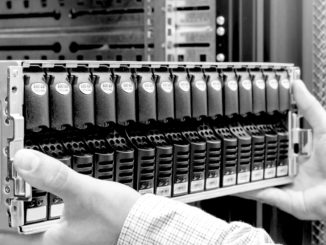
DataDirect Networks announced it is purchasing Nexenta, a software-defined storage (SDS) specialist based in Silicon Valley. The acquisition will give DDN an expanded presence in the enterprise, telco, and service provider markets, as well as provide a more complete set of storage offerings for the company’s traditional HPC and AI customers.
The acquisition comes just seven months after buying Tintri, an enterprise storage company that had filed for bankruptcy. The company offers software for server virtualization, DevOps and VDI, in addition to all-flash and hybrid flash storage arrays. Since the 2018 acquisition, Tintri – now a separate group under DDN – has reported revenue growth of 300 percent and a positive cash flow in the first quarter under its new owners.
The Nexenta deal is occurring under much less dire circumstances. Although still technically a startup, the company has been around since 2005 and now has more than 3,000 paying customers spread across North America, Asia, and EMEA. Its SDS software is offered in four flavors: NexentaStor (for enterprise applications), NexentaEdge (for cloud-based applications), NexentaCloud (for enterprise NAS aimed at AWS), and NexentaFusion (a storage management and analytics suite). Currently there are more than two exabytes of storage being managed by one or more of these products.
Most of Nexenta software is licensed through its hardware partners, primarily Supermicro, Dell, HPE, Lenovo, Cisco, Fujitsu, Western Digital, SanDisk, and Seagate. Such an arrangement not only makes it a lot easier for a 100-person outfit like Nexenta to get its products into the market, but also puts some big-name heft behind its software. As a private company, there isn’t much financial information available for Nexenta, and it’s not even clear if they are cash-flow positive at this point.
Tarkan Maner, Chairman and CEO tells us that they have had “nice growth over the past few years” and have maintained a high gross margin. Under its new management, the plan is to take advantage of DDN’s more established global market presence and open up opportunities for new accounts. “In this case, one plus one equals three,” said Maner.
From DDN’s perspective, along with the Tintri purchase, Nextenta give them another entry point into the larger enterprise and cloud markets. And like Tintri, Nexenta will be run as a distinct group within the company. Kurt Kuckein, DDN’s Director of Marketing, told us there is little overlap between the product sets and there are no immediate plans for integration between the two. “What we see is a good aggregate opportunity to provide additional services to the enterprise,” Kuckein explained, adding that they will let Nexenta continue to pursue its partner relationships and customer base.
That doesn’t rule out that some sort of product integration will come into play further down the road. One place to start might be DDN’s Infinite Memory Engine (IME), which represents the company’s primary software-defined storage offering at present. IME offers I/O acceleration by way of a flash-powered burst buffer. And while the company offers it as part of a turnkey storage appliance, the IME software can also be deployed on top of a customer’s existing flash storage system. It’s not hard to envision some cross-pollination here.
One area that Nexenta might offer shorter-term returns to DDN’s core business is in the telco realm, a market where the HPC storage-maker doesn’t have much of a presence today. Nexenta has been traditionally strong with this set of customers, especially in support of 5G infrastructure and the associated IoT use cases. According to Kuckein, DDN has a few of its storage systems deployed at telecommunication companies, mainly for the purpose of supporting analytics workloads, but with the coming intersection of 5G, IoT, and AI, he thinks a much larger opportunity is in the making. “This will extend our reach in those accounts multi-fold,” he said.
Another area where Nexenta can tee up some additional opportunities for DDN is in the vehicle manufacturing arena. Maner says one of their biggest customers is an automobile company that is currently in the process or developing its self-driving and connected car capabilities. Right now, they are using Nexenta SDS as part of their cloud-native application development environment, but once those applications move to production scale deployments, Maner thinks they will “need the performance and capacity of a traditional DDN type of solution.”
Another area where some tag-teaming is possible is in their common customer base, including educational and research institutions. The two companies are serving different workloads at those organizations, but by offering their respective solutions under a single provider, there are likely to be some additional synergies to extract.
Financial terms of the acquisition were not disclosed, but presumably it will be enough to pay off Nexenta’s numerous investors, which include SoftBank, Sierra Ventures, TransLink Capital, and Four Rivers Group, and Menlo Ventures, to name a few. Crunchbase estimates total funding at $141.5 million.
As far as DDN is concerned, we would guess this is not the last acquisition we’ll be hearing about. In fact, Kuckein suggested as much, noting that they are still on the lookout for other companies that would deliver other growth opportunities. Stay tuned.





Be the first to comment